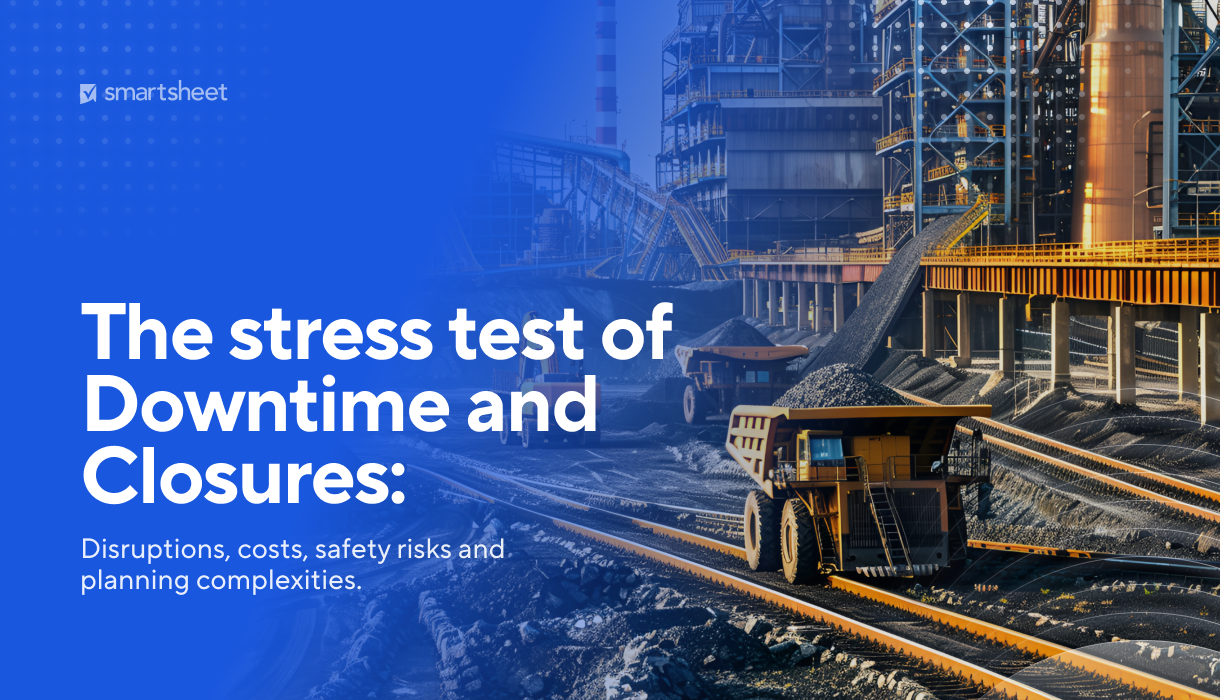Article
The stress test of downtime and closures: disruptions, costs, safety risks and planning complexities
September 5, 2024

Downtime is a costly reality in the mining and manufacturing sector. Optimising uptime and productivity requires the occasional break for maintenance, repairs and modifications. And site closures are a fact of life when resources are depleted or an operation is no longer commercially viable.
But the expectation to manage shutdowns and closures cost-effectively without compromising safety, compliance or community expectations puts mining and manufacturing leaders under intense pressure.
Good planning and efficient execution of maintenance and rehabilitation projects is essential to meet regulatory standards, address technical challenges, protect your workforce and minimise revenue risks. Let’s explore this challenge in more detail.
The complexity and costs of downtime and closures
Yes, time is money. Any stoppage of production reduces your potential revenue. Poorly managed downtime and closures can deepen a company’s losses, and create significant stress for workers and uncertainty for communities.
Job losses, environmental damage, disrupted supply chains, and the hit to Australia’s industrial capability can also damage your company’s reputation and have serious political ramifications.
Some of the key challenges in managing shutdowns and closures include:
- Downtime can be unexpected: Ideally, shutdowns and closures are planned in advance—but technical issues, accidents, natural disasters, market changes or regulatory decisions can all force downtime unexpectedly. Great preparation and streamlined project management processes are key to executing well at short notice.
- Poor planning leads to delays: Delays add to the time and manpower required to get the job done. An overlooked task or low-quality workmanship can have serious ripple effects that can only be solved by postponing other work or adding to your headcount.
- Coordinating resources is difficult: Hundreds or thousands of employees, partners, and contractors may be involved. Managers plagued by a lack of visibility of resource capacity find it hard to create teams and assign tasks. Teams may struggle to act with urgency due to disjointed collaboration across various departments.
- Regulatory controls demand precision: Micro and macro visibility of a project’s progress is needed to meet regulatory approval processes and deadlines, especially during closures that can extend over years. Oversights open the door to legal risks, fines and ongoing environmental and safety liabilities related to water, soil and air quality.
On top of these complex project management issues, if repair or site remediation work isn’t effectively managed, it can:
- Put the lives of your crew at risk due to faulty equipment
- Reduce productivity due to unreliable or inefficient plant
- Exacerbate environmental damage and social impacts
- Lead to backlash from the public, governments and investors
How to mitigate risks in shutdown and closure projects
Shutdowns also represent an opportunity to proactively prevent failures or fatalities during regular operation. Or, in the case of closures, to leave a positive legacy that helps to maintain your social licence to operate.
In other words, handling shutdowns and closures well delivers long-term, strategic gains.
To make this a reality, it’s important for miners and manufacturers to:
- Plan ahead and identify risks: You’ll feel reassured with a comprehensive plan in place. But contingency plans also need to be backed up by predefined project assets and easy-to-use tools for capturing data about equipment, risks, resourcing, and the work pipeline. That kind of visibility expedites project execution to ensure compliance, process improvement and course-correction as needed.
- Create effective communication channels: Overcome data silos and miscommunication across large teams and complex, interdependent workflows. Prioritise tools that let you easily see your progress on tasks, escalate issues, send notifications, and create reports at both a granular and portfolio-level. You’ll also want tools that let you get people’s input or share data without giving people access to irrelevant or sensitive information.
Repeatable and scalable shutdown and closure processes give mining and manufacturing leaders more scope to focus on creative solutions and transition planning. For instance, mature project management gives you the right level of data and control to:
- Spend more time on plans for repurposing or re-using a site or its infrastructure to continue to deliver economic or social value to the surrounding community.
- Apply strategies to replace equipment or assets, reduce energy use and wastage, or introduce innovation to create a greener supply chain in line with your emissions reductions targets.
Advance your project toolkit to refine shutdowns and closures
When production grinds to a halt, your revenue, labour costs and customer satisfaction can all suffer. Reducing downtime complexity and costs is possible with end-to-end project management tools that improve visibility, productivity, and consistency of processes.
For example, Smartsheet lets you create a standardised suite of shutdown and closure project plans, automated workflows and reporting that you can easily roll-out across any site. You can align teams and get started on core activities quickly.
Smartsheet features that help you accelerate maintenance and rehabilitation projects include:
- Templatised project frameworks that let you quickly roll out project plans and materials at scale.
- Customisable and automated workflows to speed up intake and cut manual admin of approvals, onboarding, alerts and updates.
- Visibility of employees’ availability and workloads to pull together the best team for the job, avoid over-allocating work, and forecast your hiring needs.
- Tailored experiences and identity-based data access for each team member to make collaboration straightforward and reduce the risk of data breaches.
- Automated portfolio-level reporting that is based on granular task level data and reliable summary data from across a range of teams and activities, providing accurate Executive and GM-level reporting across an entire portfolio.